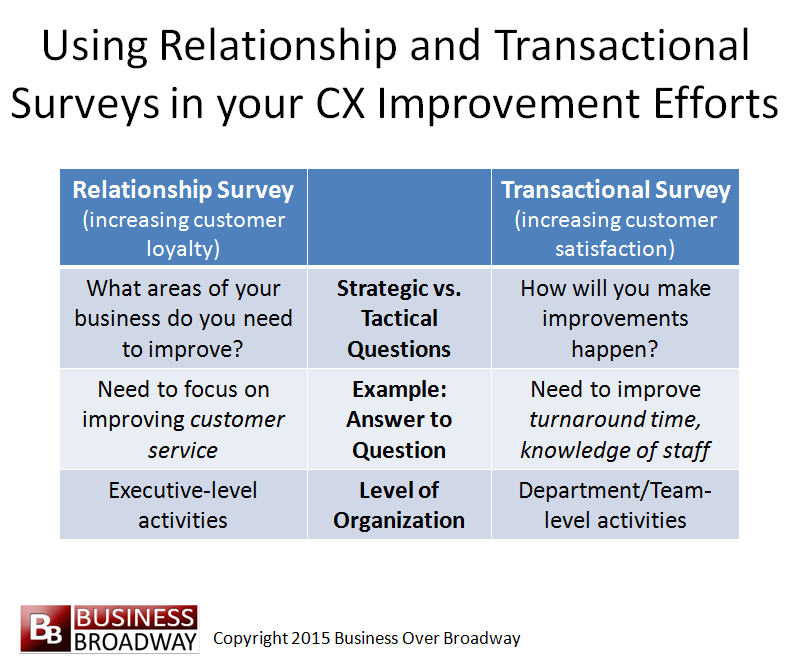Customer experience (CX) improvement efforts rely heavily on the use of customer feedback. While there are many different methods of collecting this feedback, customer surveys remain a popular choice among CX professionals. In this post, I will discuss how senior executives can use relationship and transactional surveys to get the information they need to make better strategic and tactical decisions.
Relationship Surveys
Relationship surveys allow customers to indicate their satisfaction about their overall relationship with the company/brand. Relationship surveys are typically administered at regularly scheduled times (e.g., annually) and ask the customers to indicate their loyalty toward and satisfaction with the company across several business areas (e.g., product, service) over a non-trivial time period (6-12 months).
Relationship survey questions fall into four categories:
- Customer Loyalty – survey questions reflect three general types of customer loyalty: advocacy, purchasing and retention
- Customer satisfaction with the customer experience – survey questions reflect broad touch points across the customer journey (e.g., product, technical support, communication)
- Relative Performance – survey questions reflect your ranking against the competition
- Open-ended – survey questions uncover reasons behind the ratings
Relationship Surveys Tell You Where to Improve
Relationship-level surveys focus on understanding different CX touch points that drive customer loyalty. By design, the relationship survey assesses multiple CX touch points. Data from relationship-level surveys allows executives to prioritize which touch points contribute most to customer loyalty. CX areas in which customers are dissatisfied and drive (highly predictive of) customer loyalty are referred to as key drivers. Improving customer satisfaction in these key drivers will lead to increases in customer loyalty.
The customer relationship survey helps executives identify where in their business they need to make improvements occur. The relationship survey, however, is less useful in helping executives understand what they need to do to make improvements occur (e.g., I know I need to improve tech support quality but what do I do to improve it?). As a start, you can cull insights from dissatisfied customers’ open-ended comments about a given touch point. This method provides a good starting point for generating a list of reasons why they are unhappy, however, we need to prioritize those reasons. We do this using the transactional survey.
Transactional Surveys
Transactional surveys let customers indicate their satisfaction with a specific event/transaction/interaction with the company, typically revolving around a specific customer touch point (e.g., sales process, product quality, support quality, communication). Unlike relationship surveys, transactional surveys are administered immediately or soon after the customer had a specific interaction with the company (e.g., support, sales, product).
While a business uses one customer relationship survey, that same business could employ multiple transactional surveys, each addressing a specific interaction or touch point. Transactional survey questions will generally fall into four categories:
- Overall Satisfaction with the Event/Transaction/Interaction – One survey question reflects customers’ overall evaluation of their experience
- Customer satisfaction with customer experience – survey questions reflect specific touch points about the specific experience. These questions can be guided by the results of the review of open-ended comments from the customer relationship survey as well as the results of your journey-mapping exercise.
- Relative Performance – survey questions reflect your performance ranking against the competition
- Open-ended – survey questions uncover reasons behind the ratings
Transactional Surveys Tell you How to Improve
The results of the relationship survey (e.g., identifying where to make improvements) will dictate which transactional survey you need to conduct. I recommend conducting transactional surveys on processes/touch points that were identified as key drivers from your relationship survey results (e.g., CX areas that didn’t score high on customer satisfaction and are important to driving loyalty.
Unlike the relationship survey where our focus was to understand the comprehensive customer experience over time, transactional surveys are focused on a specific interaction/touch point. The focus of a transactional survey is on achieving a deeper understanding of what aspect of the experience left them dissatisfied. If the relationship survey identified “technical support” as a key driver, a transactional survey on technical support would help identify the specific ways you can improve technical support quality to improve satisfaction with technical support.
The transactional survey helps executives identify how to make improvements happen.
Summary
When you think about customer relationship and transactional surveys, it’s best to think of them as complementary efforts in your quest to improve how you do business. Your relationship survey helps you understand where you need to make improvements (e.g., product, service, marketing) while transactional surveys help you identify what needs to be done to improve those experiences. In other words, relationship surveys provide information to help with CX strategic decisions (e.g., what areas of the business you need to improve); transactional surveys provide information to help with tactical decisions (e.g., how are you going to make CX improvements happen). Figure 1 summarizes how relationship surveys and transactional surveys fit into CX strategic and tactical decision-making.
Conduct the relationship survey first and let those results guide your decision about which transactional survey you need to undertake. Using both survey methods provides necessary insights to help you make better strategic and tactical decisions to enhance the customer experience, improve customer loyalty and drive business success.
A version of this article first appeared on CustomerThink.




 Beyond the Ultimate Question
Beyond the Ultimate Question Measuring Customer Satisfaction and Loyalty (3rd Ed.)
Measuring Customer Satisfaction and Loyalty (3rd Ed.)
[…] the attitudes of their customers using customer surveys. The purpose of these surveys, typically conducted annually, is to help companies maintain or […]
[…] Customer experience (CX) improvement efforts rely heavily on the use of customer feedback. While there are many different methods of collecting this feedback, customer surveys remain a popular choice among CX professionals. […]
[…] in the experience (in the moment). These survey approaches are used to help businesses improve strategic and tactical decision-making, […]